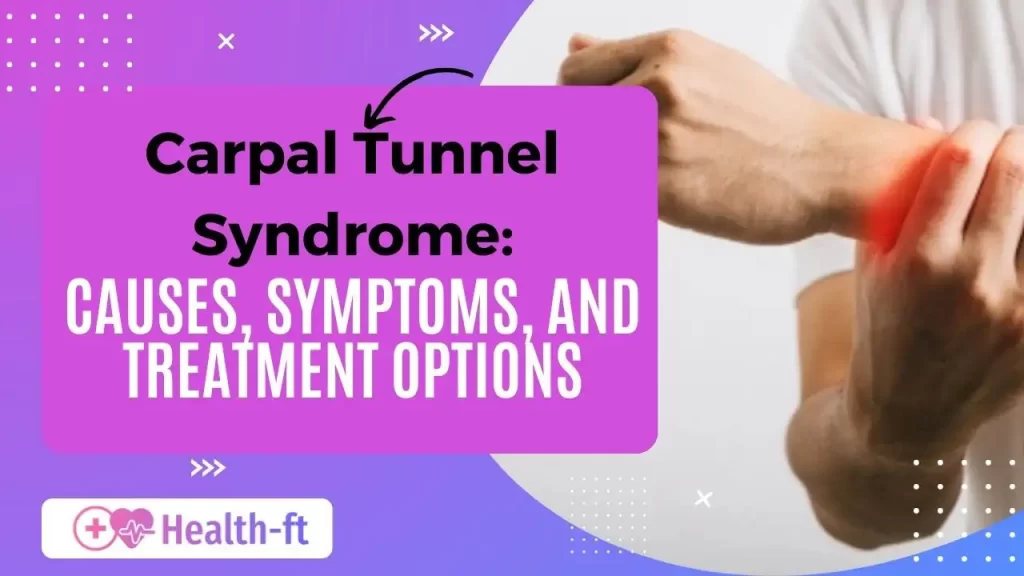Carpal Tunnel Syndrome (CTS) is a common condition that affects the hands and wrists. It often causes discomfort and hinders daily activities. If left untreated, CTS can lead to serious complications, including permanent nerve damage. Whether you’re experiencing symptoms, at risk of developing CTS, or simply seeking to understand it better, this guide will provide the clarity you need.
Key Takeaways:
- Definition: Carpal tunnel syndrome is caused by compression of the median nerve within the carpal tunnel in the wrist.
- Symptoms: Common symptoms include numbness, tingling, pain, and hand weakness.
- Causes: Risk factors include repetitive hand movements, medical conditions (e.g., diabetes), hormonal changes, and wrist injuries.
- Treatment Options: Non-surgical approaches like lifestyle changes, wrist splints, and carpal tunnel syndrome medication can be practical; severe cases may require surgery.
- Prevention: Proper ergonomics, regular breaks from repetitive tasks, and healthy habits can lower the risk of carpal tunnel syndrome.
What Is Carpal Tunnel Syndrome?
Carpal Tunnel Syndrome is caused by the compression of the median nerve, which runs through the carpal tunnel in the wrist. The carpal tunnel is a narrow passageway surrounded by bones and ligaments, including the transverse carpal ligament. It houses the median nerve and tendons that help control hand movements. When the carpal tunnel becomes swollen or narrowed, it places pressure on the median nerve, resulting in pain, tingling, and other symptoms. Carpal tunnel syndrome pain relief is often sought after by millions of people affected worldwide.What Are the Carpal Tunnel Syndrome Causes?
The exact cause of carpal tunnel syndrome can vary, but several factors contribute to its development:- Repetitive Hand Movements Activities involving repetitive wrist motions, such as typing, writing, or using a carpal tunnel syndrome mouse, are common triggers. Continuous strain on the wrist can irritate the tendons, leading to swelling that compresses the median nerve.
- Medical Conditions Certain health conditions increase the likelihood of developing carpal tunnel syndrome:
- Diabetes: Can damage nerves, including the nerves in thumb.
- Hypothyroidism: Causes fluid retention, leading to swelling in the wrist.
- Rheumatoid Arthritis: Chronic inflammation of the joints may narrow the carpal tunnel.
- Hormonal Changes Hormonal fluctuations during pregnancy or menopause often lead to fluid retention, which can place pressure on the median nerve.
- Wrist Injuries Fractures, sprains, or any wrist trauma can reduce the space within the carpal tunnel, making compression more likely.
- Genetic Predisposition Some people inherit smaller carpal tunnels, which increases their vulnerability to nerve compression.
- Obesity and Lifestyle Factors Excess weight places additional strain on the wrist, and unhealthy habits like smoking can impair blood flow, exacerbating symptoms. Learning how to avoid carpal tunnel through lifestyle changes can be effective.
What Are the Carpal Tunnel Syndrome Symptoms?
CTS typically starts with mild symptoms that can worsen over time. Early recognition is crucial to prevent long-term complications. Common symptoms include:- Numbness and Tingling: A “pins and needles” sensation, especially in the thumb, index, middle, and ring fingers.
- Pain on thumb tip: This can sometimes extend to the forearm.
- Weakness: Affected individuals may struggle to grip objects or perform fine motor tasks.
- Shock-like Sensations: Sudden jolts or shooting pain in the fingers.
- Muscle Atrophy: In advanced cases, the muscles at the base of the thumb may weaken and shrink.
How Is Carpal Tunnel Syndrome Diagnosed?
Diagnosing carpal tunnel syndrome involves a combination of medical history, physical examination, and diagnostic tests:- Physical Examination
- Tinel’s Test: The doctor lightly taps the wrist over the median nerve to check for tingling or discomfort.
- Phalen’s Test: The patient is asked to flex their wrist for a minute to see if symptoms are reproduced.
- Nerve Conduction Studies These tests measure the speed at which electrical signals travel through the median nerve, helping confirm compression.
- Imaging Techniques Ultrasound and MRI may examine the wrist’s structure and identify any abnormalities or inflammation.
What Are the Carpal Tunnel Syndrome Treatment Options?
Carpal Tunnel Syndrome Treatment varies based on the severity of symptoms. Here’s an overview of the available options:Non-Surgical Treatments
- Lifestyle Changes: Avoid repetitive wrist movements and adjust your workspace ergonomically.
- Carpal tunnel syndrome wrist brace: Wearing one at night can keep the wrist neutral, reducing pressure on the median nerve.
- Carpal tunnel syndrome therapies: Stretching and strengthening exercises improve wrist flexibility.
- Carpal tunnel syndrome medication: Over-the-counter NSAIDs (e.g., ibuprofen) can help manage inflammation and pain.
- Carpal tunnel syndrome self-care: Regular hand and wrist exercises can reduce symptoms effectively.
Surgical Treatments
When conservative treatments fail, carpal tunnel syndrome surgery may be necessary to alleviate symptoms. The most common procedure is carpal tunnel release, which involves cutting the ligament and compressing the median nerve.How Can You Prevent Carpal Tunnel Syndrome?
While CTS cannot always be prevented, certain practices can significantly reduce the risk:- Ergonomics: Optimize your workstation by keeping your wrists in a neutral position.
- Carpal tunnel syndrome exercises: Perform hand and wrist exercises to maintain strength and flexibility.
- Take Breaks: Regularly pause and stretch your wrists during repetitive tasks.
When Should You Seek Medical Attention for CTS?
If you experience persistent symptoms such as carpal tunnel syndrome, shaking hands, numbness, or pain, consult a healthcare professional. Early diagnosis and intervention are essential.Conclusion
Carpal Tunnel Syndrome may seem daunting, but it’s a highly manageable condition with the right knowledge and timely intervention. There are effective solutions for everyone, from lifestyle adjustments and non-invasive treatments to surgical options. By recognizing the early signs and seeking medical advice, you can take control of your hand health and ensure that CTS doesn’t hinder your quality of life. Remember, prevention is always better than cure. Prioritize ergonomics, take breaks, and keep your wrists healthy to stay ahead of CTS.FAQS
What is the corti trial signal for Carpal Tunnel Syndrome?
Yes, individuals with Type 1 diabetes can live as long as others now that treatments have improved and many diseases well managed. Practicing good measurements of blood sugars, taking insulin doses, and adopting healthy lifestyles are ways of raising life span.
What will happen if carpal tunnel syndrome is not treated?
If Carpal Tunnel Syndrome is not treated, it can lead to permanent nerve damage, resulting in chronic pain, numbness, and weakness in the hand. Over time, it may also cause muscle atrophy, particularly at the base of the thumb, affecting hand function.
What will happen if carpal tunnel syndrome is not treated?
If Carpal Tunnel Syndrome is not treated, it can lead to permanent nerve damage, resulting in chronic pain, numbness, and weakness in the hand. Over time, it may also cause muscle atrophy, particularly at the base of the thumb, affecting hand function.
Is there an auto-therapeutic remedy possible for Carpal Tunnel Syndrome?
Carpal Tunnel Syndrome can be treated conservatively by abstaining from activities that initially brought on the pain, avoiding using the affected wrist at work, using a wrist brace, and altering the workstation to accommodate the wrist. But sometimes, it might worsen to the next level, where surgery or medical treatment might be necessary.
How do you know if your carpal tunnel is healing after the operation?
Recovery is quite different in each case, and generally, most patients are able to commence light activities in about two weeks. For complete recovery, it may take close to 6 months, though the process depends on the invasiveness of the surgery or the seriousness of the symptoms before the surgery.




